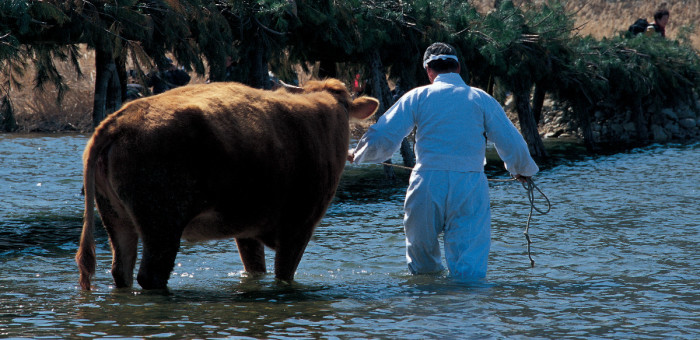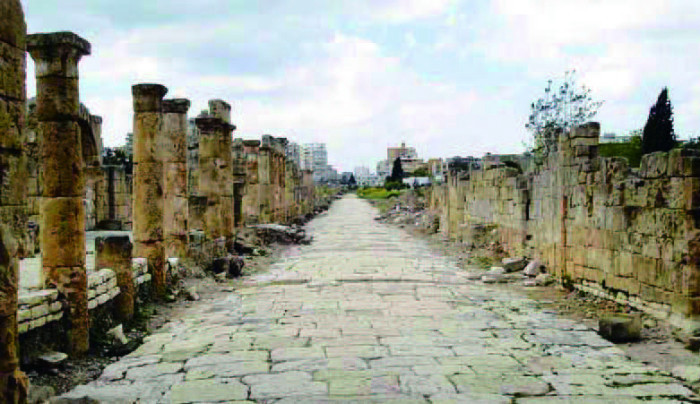GyeongGi Cultural Foundation
Traffic and Road
Roads of Namhansanseong
"Stories on the Road" is a story about a UNESCO World Heritage site and a story. It will tell you the life and spirit of our ancestors in the ancient road of The old Namhansanseong path. |
A Trip to Majang-dong

“1-day living pattern by foot from Namhansanseong Fortress to Majang-dong, Seoul”
In Seoul where transportation had developed most rapidly, walking was the primary means of transportation in the 60s and 70s. It was said that people would walk from Namhansanseong Fortress to Majang-dong 50 years ago to sell cattle—a distance totaling 21 km. Let's guess how long it took for the storyteller to walk 21 km. The departure time is 1:00 AM, when the night is completely dark, and the arrival time is about when the sun rises during fall, so it must be around 7:00 AM, which is a 6-hour journey. The calculated pace is 3.5 km per hour, identical to normal walking speed. Residents living in the vicinity of Namhansanseong Fortress usually left at dawn, and after taking care of their businesses in the morning in Seoul would leave the capital in the afternoon to return home at about sunset. This was a “1-day living pattern” by which you could visit Seoul and come back home within the same day. The boundary of this 1-day living pattern included today’s northern Gwangju, Seongnam, and Hanam, all of which are located within a range of 20 km one-way and 40 km round trip.
The Roads of Rome – The Roads of Joseon

The perfectly paved highways of Rome
“The Roads of Joseon, displaying the unique characteristics of its world view”
The roads of Rome and of Joseon symbolically display the characteristics of the different world views held by each nation. For the Romans, the world around Rome was considered an object of conquest and civilization. According to the Joseon view of the world, on the other hand, Joseon was not the center of East Asia in the middle ages. The term that summarizes the external relations of Joseon was sadae gyorin, meaning that it reveres the Ming Dynasty and forms good relations with other ethnic groups, defining its attitude with detachment from any sort of conquest. With the exception of the early years, Joseon was extremely passive in seeking to venture outside the nation, either by ocean or via the continent. A nation reluctant in struggles with the outside and another that actively conquered the surrounding world; the differences in the world views of Joseon and Rome are revealed in the narrow and wide paths used by the two nations.
Road management

Pontoon bridge from 『Wonhaeng Eulmyojeongri Eugye』
“Is it a waste of labor to pave and manage roads?”
In the late Joseon Dynasty when the importance of roads began to be recognized, many scholars criticized the road conditions of Joseon at the time. Even in the face of criticism from the intellectual classes, Joseon society still had no intentions to manage roads. However, there was only one exceptional situation where the roads were managed: when the king would travel on these roads. Typical trips for kings at the time were a spa onhaeng (to hot springs) or neunghaeng (to the royal tombs). Kings occasionally made trips to specific regions in the country for rest and recuperation, but the renowned hot springs locations were quite far. Neunghaeng, which was more frequent than onhaeng, covered a shorter distance, as most of the royal tombs were located not far from the four main gates of Hanyang. There were, however, two long-distance neunghaeng routes – Yeongnyeongneung, with the tombs of King Sejong and King Hyojong, and Yungneung, with the tomb of Crown Prince Sado. Meanwhile, King Jeongjo went to visit the royal tombs quite often, and thus many articles could be easily found regarding road maintenance and reinforcement for neunghaeng trips during his reign. But, looking at the entire history of Joseon, there are not many records on the government’s active efforts to maintain roads at the national level except for the long-distance royal trips of kings. Even in the late Joseon period when commercial distributions became more active, the increasing number of merchants and tourists still had to travel on inconvenient pathways.
<Copyright(c)2002 GGC All rights reserved.>
information
Stories on the Road
Published by/ Namhansanseong World Heritage Centre, Gyeonggi-do The Center for Gyeonggi Studies, Gyeonggi Cultural Foundation
Published on/ November 24, 2017
Supervised by/ Lee Ji-hoon, Director of the Center for Gyeonggi Studies, Gyeonggi Cultural Foundation
Planned and coordinated by/ Chae Chi-yong, Senior Researcher at the Center for Gyeonggi Studies, Gyeonggi Cultural Foundation Park Da-seul, Researcher at the Center for Gyeonggi Studies, Gyeonggi Cultural Foundation
keywords
- Writer
- GyeongGi Cultural Foundation
- About
- Everything about the GyeongGi arts and culture, GGCF
- homepage
- http://www.ggcf.kr